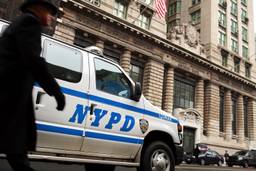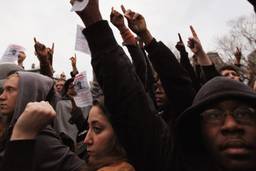
In nearly two dozen states on Tuesday, the Occupy movement staged demonstrations in which protesters reclaimed foreclosed homes for needy families. The actions marked a new stage in the evolution of OWS, which is no longer comprised of passive campsites awaiting eviction by the state, but rather a network of direct action chapters.
This time around, OWS bypassed the endless, maddening bureaucratic goose chases many homeowners find themselves trapped in when suddenly their mortgages become twice the price tags of their homes. Instead, Occupy and other housing rights groups joined forces to reclaim the foreclosed homes, renovate the interiors, and make dilapidated spaces liveable again, simply because the groups believe every human being has the right to affordable housing, and families should not be made homeless due to the unscrupulous actions of big banks.
Elizabeth Owens, a member of the community group VOCAL-NY, expressed frustration with city leaders. “They’re not putting out housing for anybody out here. We’re suffering and they’re sticking us in shelters and places that are unbearable,” she said. “How can we move on with our lives if you won’t give us a life? We’re wondering why there are all these foreclosed buildings around here and they’re not putting anybody in them. That’s why we’re out here. We’re fighting for the 99 percent: low-income housing, jobs, everything they need to focus on.”
Owens also added she’s a great supporter of what OWS is trying to achieve. “We do want millionaires to pay their fair share in taxes. All these years, they’ve been pocketing money and everything, and at the same time, telling us the city is broke.”
In November, journalist Tana Ganeva reported that Mayor Bloomberg’s administration announced new eligibility rules that made it harder for homeless people to get into shelters as part of a citywide austerity package. The new rules state that the city can refuse someone a bed at a shelter unless they prove they had no other housing options. This was yet another bureaucratic hurdle placed in the way of needy individuals.
Meanwhile, a report by Coalition for the Homeless released Wednesday found that the numbers of unhoused New Yorkers have shot up to their highest in three decades – 41,000 adults and kids sleeping in shelters – according to data analyzed by the group’s researchers. The Coalition points out that the Bloomberg administration’s decision last spring to eliminate housing assistance programs for homeless families has not helped matters.
The situation is particularly tumultuous for people living with HIV and AIDS, such as Orio Perez, a member of VOCAL-NY, who has been HIV-positive since 1995.
“We’re homeless, we have no housing. There’s a lot of homeless people sleeping in the streets, begging for money, it’s terrible,” said Perez, adding the shelter situation is even worse, if an individual is even “lucky” enough to make it inside. “In shelters, they steal all your stuff. It’s full of drugs, selling drugs, using drugs. It’s disgusting. It’s horrible…People are shooting [drugs] in the bathrooms, smoking in the bathrooms, sex in the bathrooms. It’s horrible.”
Occupy, along with housing rights groups, and community action veterans like Councilman Charles Barron and former ACORN head Bertha Lewis, staged a foreclosure tour of East New York, an area infamous for its high poverty and crime rates. Walking through East New York is like touring a post-apocalyptic America in which every sixth home’s facade is boarded up. At one point, the march passed a house’s door, which laid in the middle of the street, its paint chipped and frame splintered.
Oddly, the NYPD allowed the march to proceed down the middle of the street, which actually did disrupt traffic more than a few times. Apparently, the NYPD only cares about protesters disrupting traffic if the individuals stuck in those cars are driving Mercedes and travelling through the financial district.
The foreclosure tour was comprised of a handful of locations, which served as rallying points where speakers testified about their experiences battling bank foreclosure.
At one point, a woman in the crowd starting screaming, and interrupted the people’s mic. Occupy activists brought her up to the stoop and the woman was given some time to tell her story. Through sobs, she explained that her son had served in Iraq and was killed in battle. “I cannot sleep! I cannot eat!” she cried. “My son died in Iraq in the army! I bought my house in 1997. I put down $80,000. I’ve been doing two jobs my whole life.” And yet, her hard work wasn’t enough to keep her head above water when the ballooned mortgage payments landed at her doorstep.
A young man named Quincy also testified about being tricked into signing over the deed to his home, and explained he was going to be evicted that very night before he broke down in tears.
Later in the evening, a group of around 50 people walked to Quincy’s house in order to defend it from the eviction. The action unfolded on Twitter under the hashtag #Quincyhouse, and the small group was able to fend off the eviction, at least for the time being. At around 8 PM, the NYPD did charge the home even though police are technically supposed to wait for a marshal to start the eviction, but there were no arrests. Quincy will reportedly have an opportunity to show they have a right to the home in court today.
The final stage of the tour unfolded at 702 Vermont St, the location of a new home for a selected family. Tasha, a mother roof two children (ages 9 and 5) has been unable to find steady employment due to a combination of factors including the sparse jobs market and caring for her children, one of whom is autistic.
Protesters greeted the family with balloons and a new Christmas tree for their home and played music in celebration as Councilman Barron led the way into their house.
The model of reclaiming foreclosed homes is one that Occupy hopes to export to every city in the United States. Nelini Stamp, an OWS activist, said the action was about “bringing the symbolic to the real.”
“It’s important to highlight the extreme oppressive housing business, or market, right now,” she said, adding that the foreclosure rate in East New York is five times the statewide rate.
This kind of action makes me think that perhaps the eviction from Zuccotti Park might have been the best thing that could have happened to Occupy because the group seems to be most effective when bringing its message of justice and direct action into the communities hardest hit by the country’s growing wealth divide.
Groups like VOCAL-NY, Organizing For Occupation, Occupy the Hood, and Occupy Our Homes are by far the most diverse organizations, in every way (age, race, gender, etc.) While the young, predominately white college-age students who previously set up camp in Zuccotti have every right in the world to feel disenfranchised and furious with their government, a social justice movement can’t truly be effective until that movement empowers the first victims of Wall Street’s swindle, poor people of color, instead of well-meaning supports simply hypothesizing about them about from afar.
Truly, Occupy fighting for affordable housing really does represent the interests of the 99 percent.
–
Below is a slideshow of some photos I took during the march, including Councilman Barron and Bertha Lewis marching, some of the foreclosed homes, and finally the reclaimed house and subsequent block party.




